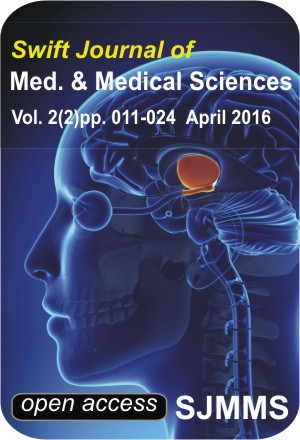Journal Categories

Swift Journal of Medicine and Medical Sciences (SJMMS)
April 2016 Vol. 2(2), pp. 011-024
Copyright © 2016 Swift Journals
Original Research Paper
Application of Fourier Transform Infrared (FTIR) Spectroscopy and Atomic Force Microscopy in Stroke-Affected Brain Tissue.
Mohamed. H. M. Ali1, , Khalid Al-Saad2, , Anton Popelka2, Geralda van Tilborg3, Erik Goormaghtigh4
1(Qatar Biomedical Research Institute, QBRI, Doha, Qatar).
2(Qatar University, (Khalid Al-Saad, Depratment of Chemistry) and (Anton Popelka, Center for Advanced Materials, Doha, Qatar).
3Biomedical MR Imaging and Spectroscopy Group, Center for Image Sciences, University Medical Center Utrecht, Utrecht, the Netherlands.
4Université Libre de Bruxelles, Structure and Function of Biological Membranes Center for Structural Biology and Bioinformatics Brussels, Belgium.
*Corresponding Author E-mail: moaam@yahoo.com
Accepted 26th January, 2016
Abstract
Fourier transform infrared (FTIR) spectroscopy was assessed as a potential rapid and objective diagnostic platform to investigate pathological and physiological changes at 9 weeks post stroke. Atomic force microscopy (AFM) was also used in order to investigate the changes in bio-mechanical and bio-physical properties of the brain due to stroke. Unilateral stroke in the sensorimotor area was induced by photothrombosis in rats, under 1.5-2% isoflurane anesthesia. Brains were extracted, post-fixated in 4% paraformaldehyde and embedded in paraffin. FTIR spectra of the stroke-affected samples showed that there is a decrease in the white matter lipid content. The FTIR results indicated that there are bio-chemical changes in amide I band in the protein region as well as in the ester band. Principal component analysis (PCA) in the 1800-1000 cm-1 spectral range showed that the white matter in stroke-affected brain sample exhibits chemical composition changes in an amide I, amide II and ester bands. AFM results implied that physical changes in the stroke samples led to the significant increase of the surface roughness as the result of increased tension in the brain tissue. The changes in the surface morphology resulted in the increase of mechanical parameters such as elastic modulus (Er) and hardness (H) of stroke samples. FTIR spectroscopy in combination with chemometric analysis a non-destructive and powerful approach to be used as a medical diagnosis tool in order to investigate the pathological changes associated with stroke in the brain tissues. The AFM confirmed that the surface roughness increase in stroke samples.
Keywords: FTIR, Brain stroke, PCA, AFM, Surface morphology and Nanoindentation
Read [Full Text - PDF]
